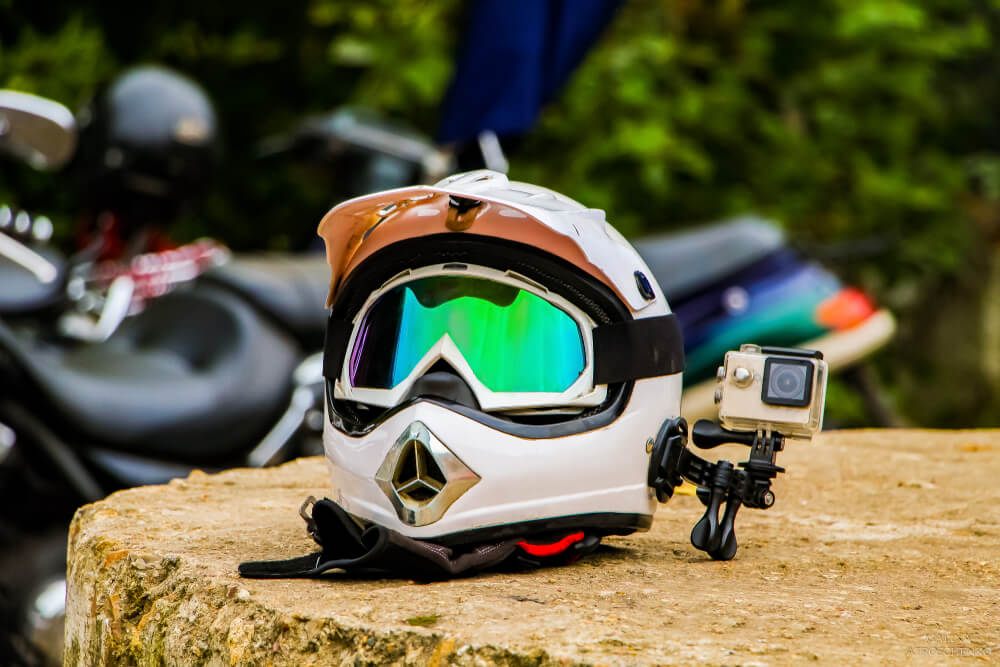Cameras are everywhere — walk down the street, and your face will likely be captured by CCTV footage installed on nearby buildings, if not in the background of a video or selfie recorded or taken on a cell phone. Even when you visit someone else’s home, it’s common these days for many to have a doorbell camera installed.
But on some roads, especially highways, you won’t find many cameras, save for the odd speed cam. And if you’re unfortunate to be in a motorcycle crash, unless the driver you say caused the crash was speeding or others witnessed the accident, it’ll often be your word against theirs.
But there is a solution: wearing a crash helmet camera.
We look at why motorcyclists should wear helmet cams, including why it could be vital to proving your side of the story if you’re in an accident and want to claim compensation.
Areas in Greater San Antonio We Serve
The Case for Wearing a Helmet
Before talking about motorcycle helmet cameras, we first need to talk about ordinary helmets.
Riding a motorcycle isn’t just a way to get from A to B. It’s also a popular pastime — so popular that there are close to 9.9 million registered motorcycles in the U.S. But driving a motorcycle is also dangerous. Because these vehicles are smaller, they often sit in the blind spots of other larger vehicles — like cars and trucks — around them. Coupled with the limited protection a motorcycle affords, riders are incredibly exposed. If they’re in an accident, the damage can be life-altering, if not fatal.
It makes sense, then, that motorcyclists should be required by law to wear protective gear. You might be surprised to find that’s not necessarily the case.
A 2023 study shows that skull fractures were twice as common in motorcyclists not wearing helmets versus those who were. An older study reported that wearing a helmet minimized traumatic brain injuries by 88%. Despite these statistics, however, there is no federal law that mandates helmet use. Instead, each state adopts its own legislation. Some states have universal motorcycle helmet laws, but most (28 states) only require certain drivers or passengers to wear helmets.
Texas is one of these states, requiring all motorcyclists and motorcycle passengers under 21 to wear a helmet. As a general rule, individuals over the age of 21 must also wear a helmet, but there are two exceptions:
- The rider has passed an approved motorcycle operator training and safety course.
- The motorcyclist has medical insurance coverage to cover any injuries that may occur in an accident.
This means that any motorcyclist with appropriate insurance can freely ride around Texas without wearing a helmet, and others may be required to wear a helmet but don’t comply with the law.
The case for wearing a motorcycle helmet is clear, and even when it isn’t legally required, the Texas Department of Transport advises riders to wear headgear.
So, if wearing an ordinary helmet is enough to protect your head in an accident, why wear a crash helmet with a camera?
Why Motorcyclists Should Wear Helmet Cams
If a picture is worth a thousand words, a video is worth a million. Although a motorcycle cam can be worth its weight in gold if you’re in a crash — more on that in a moment — you likely won’t want to buy one in anticipation of getting injured in a potentially devastating crash.
Fortunately, there are plenty of positives to owning a helmet cam. It can help you enjoy the good times, share your adventures, and even become a better motorcyclist. Recording your rides and watching them back allows you to appreciate the open road from the comfort of your own home or pick up on mistakes you might make while riding, such as running wide on corners or even forgetting to stay hydrated on the road.
Of course, one of the big benefits of having footage of the road is that it can be used as evidence for when the unthinkable happens.
Without evidence, a driver who caused your crash might argue you were driving recklessly or following so closely they couldn’t see you — so the accident was your fault.
The reality is that a motorcycle crash can happen in mere seconds. A car driver might take their eyes off the road to respond to a text, come speeding down the highway at a hundred miles per hour, or briefly close their eyes due to fatigue. Unfortunately, there’s no easy way to know what happened leading up to a crash without evidence. One form of evidence is the testimony of those involved. Still, their version may be inaccurate, whether because they don’t remember, especially as their memory becomes fuzzy over time, or — more commonly — they caused the crash and don’t want to admit it.
Video provides concrete, unbiased proof, showing investigators what factors were at play. If a car driver failed to leave enough room, was speeding, or abruptly turned into you, your motorcycle helmet camera footage will show it.
This evidence can make the difference between receiving a fair compensation payout and not having a leg to stand on. You can only file a compensation claim if you have evidence that another party was liable for your crash.
Most compensation claims are successfully resolved out of court, where the other party accepts responsibility and agrees to pay you a negotiated sum to cover your expenses and compensate you for your injuries in exchange for you essentially dropping the case. You’ll sign paperwork stating that you can’t hold the party liable for any further damages.
However, in rare cases, you may not reach an agreeable number and decide to take your claim to court. The personal injury trial procedure is a long process involving pre-trial motions, discovery (collecting evidence for your court case), additional negotiations, and mediation. If you don’t settle your claim before your trial date rolls around, your motorcycle accident attorney will present your case to a jury, who will determine if the defendant (the person or party that caused your accident) is liable and, if they are, how much they should pay you.
Going to trial isn’t a decision you should make lightly, as there’s no guarantee of success. Still, one advantage is that video footage is admissible in court — assuming you wore a motorcycle helmet camera during the crash. Trials can be won or lost based on a single piece of evidence, and a video of the crash might be what swings the jury in your favor.
Choosing the Right Helmet Cam
You have several options if you’ve decided to invest in a crash helmet camera. You might be tempted to buy the cheapest on the market — something is better than nothing, right?
However, saving a few extra dollars can compromise the quality of footage a camera records, which is something you want to consider.
Nobody wants to watch grainy, pixelated footage, even if you’re recording your rides for enjoyment. Then, if you want to rely on your recordings as video evidence to prove liability, it’s even more vital that the footage is crisp and clearly shows what happened. If possible, invest in a reputable brand that is easily operated, uploads footage to the cloud (to prevent claims of tampering with evidence), works in all weather conditions, and captures clear footage even in low light.
It may cost you a bit more in the short term, but if you’re ever in a crash and need to rely on camera footage, you can make back your investment tenfold.
If you’re in a motorcycle accident in Texas, whether you have motorcycle helmet cam footage or not, get in touch with our personal injury lawyer in McAllen and San Antonio. During a free, no-obligation consultation, you’ll find out if you have a claim and how much you might be entitled to in compensation. Fill in the contact form or call 855-LAW-NINJA today.

